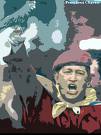Archive for November 2008
Tongue-Twisters
Posted on: November 15, 2008
- In: Education
- 2 Comments
A tongue-twister is a sequence of words that is difficult to pronounce quickly and correctly. Even native English speakers find the tongue-twisters on this page difficult to say quickly. Try them yourself. Try to say them as fast as possible, but correctly!
A proper copper coffee pot.
Around the rugged rocks the ragged rascals ran.
Long legged ladies last longer.
Mixed biscuits, mixed biscuits.
A box of biscuits, a box of mixed biscuits and a biscuit mixer!
Peter Piper picked a peck of pickled pepper.
Did Peter Piper pick a peck of pickled pepper?
If Peter Piper picked a peck of pickled pepper,
Where’s the peck of pickled pepper Peter Piper picked?
Pink lorry, yellow lorry.
Red leather, yellow leather, red leather, yellow leather.
She sells sea-shells on the sea-shore.
The sixth sick Sheik’s sixth sheep is sick.
[Sometimes described as the hardest tongue-twister in the English language.]
Swan swam over the pond,
Swim swan swim!
Swan swam back again –
Well swum swan!
Three grey geese in green fields grazing.
We surely shall see the sun shine soon.
Source: http://www.englishclub.com
To be Charismatic::…
Posted on: November 14, 2008
- In: Business | LIfe
- Leave a Comment
Why is it that some people seem to exude charisma or presence which captivates and influences those around them, while others have the opposite effect? Did you ever wish you could be more charismatic or have more presence – whether it’s while you’re teaching, public speaking, at your work place, or in your day-to-day life?
Presence is defined as the ability to project a sense of ease, confidence, and self-assurance. It accompanies all those who are charismatic. Researchers have observed that those with an infectious personality unintentionally cause others to copy their body language and facial expressions. What’s also interesting is they are impervious to the influences of other charismatic people.
Just getting someone to copy your body language isn’t the extent of what having charisma can do. As shown throughout history, charismatic leaders can transform the preferences, needs, values, and aspirations of those who follow them. Their presence and influence causes followers to make great personal sacrifices in the interest of some vision and to perform way beyond their norm. Many people attribute this to their power as an orator and say THAT is the source of their presence. Actually, it goes beyond that.
Can this be learned? The answer is a most definite yes. However, it can’t be faked. Confident, resonating
speech is only half the equation. Movements are the other half, and movements must be congruent with speech. This is where we come to The Dog Whisperer.
Ethologists – those who study animal behavior – have been able to determine that dogs are keenly aware of human body language. For example, seemingly small details such as leaning slightly forward or backward are interpreted as a threatening gesture or a non-aggressive one. Tilting your head to the side will disarm a dog while staring head on challenges him. Even the difference between slumping your shoulders and standing shoulders squared can determine whether your dog ignores or obeys you.
Phrasing is the vocabulary and syntax of gesture and movement – and dogs can read ours like a book. According to Karen Bradley, a movement expert from the University of Maryland, “Cesar has beautiful phrasing”.
Not all of us are movement experts, however subconsciously we are very aware of each others phrasing. The great communicators are those who can match their phrasing with their communicative intentions – and this is the key to their charisma and presence. It’s not just the words that matter, but how they’re presented. When someone says one thing and their body says something else, our minds are not impressed.
This can be clearly seen with some of the different Presidents we’ve had:
Movement analysts tend to like watching, say, Bill Clinton or Ronald Reagan; they had great phrasing. George W. Bush does not. During this year’s State of the Union address, Bush spent the entire speech swaying metronomically, straight down through his lower torso, a movement underscored, unfortunately, by the presence of a large vertical banner behind him. “Each shift ended with this focus that channels toward a particular place in the audience,” Bradley said. She mimed, perfectly, the Bush gaze�the squinty, fixated look he reserves for moments of great solemnity�and gently swayed back and forth. “It’s a little primitive, a little regressed.” The combination of the look, the sway, and the gaze was, to her mind, distinctly adolescent. When people say of Bush that he seems eternally boyish, this is in part what they’re referring to. He moves like a boy, which is fine, except that, unlike such movement masters as Reagan and Clinton, he can’t stop moving like a boy when the occasion demands a more grown-up response.
To develop charisma and presence we must train our motions to coincide with our intention of communication. We must learn to integrate our posture and gestures with our speech. Movement specialists say that we all have a certain phrasing baseline – it’s this baseline that we need to improve upon. Here are some examples to help you do this:
- Begin first by observing yourself. What is your body doing as you speak with others? If you are in a leadership position (such as a parent), what is your body doing when you are asking someone to do something? Do your movements seem to conflict or coincide with your words?
- Watch some of the phrasing masters, those people who particularly impress you as being charismatic and having presence. Try to pick out what it is that they do with their posture and gestures (this includes both hand and face gestures) and what they are saying in concert with their phrasing. This could be an actor, a friend, a family member etc.
- Pay particular attention to the dynamics of the movement they are gesturing. Is it smooth? Does it explode? In other words does it start off slowly, increasing momentum until it ends abruptly? Or does it do the opposite, starting off fast only to fizzle out in the end? What are they saying in connection with the movement?
- As you record your findings, begin to practice them in front of a mirror, mimicking what you observed. Are you convincing yourself?
- Only after practice, begin incorporating this into your daily life – at the workplace, with the cashier etc.
Those with presence and charisma draw a following because of their ability to say things in a way that’s appealing. Their strength lies in the ability to convey messages in a most convincing manner that charms those around them. This is a result of excellent phrasing harmonized with verbal communication. As your presence and charisma grows, and you develop your own set of followers, please refrain from creating another Nazi Germany, a bunch of Branch Davidians or a Heaven’s Gate Cult. We’ll all be very grateful.
Time is the coin of your life. It is the only coin you have, and only you can determine how it will be spent. Be careful lest you let other people spend it for you.
~ Carl Sandburg ~
Record and analyse what did you do yesterday?
- Take a piece of paper (diary, planner or spreadsheet).
- Divide your working day into half hour intervals (include travelling time & breaks).
- For each half hour interval indicate the activity you where involved in.
Note: If you can easily remember exactly what you were doing for all the intervals you are better at this than me. - Highlight in:
- Red activities not helpful in meeting your objectives.
- Orange marginal activities i.e. travelling, waiting, lunch etc.
- Yellow time spent in planning or thinking.
- Green activities helpful in meeting your objectives.
- You can now see at a glance how you use your time.
- From now on record what you do when you plan it or when it occurs.
- Review weekly how you spend your time.
The idea is to make decisions and act on them — to decide what is important to accomplish, to decide how something can best be accomplished, to find time to work at it and to get it done.
~ Karen Kakascik ~
Effective use of time
- Concentrate on being effective, not on being busy.
- Avoid red activities (time spent which is not helpful in meeting your objectives). Analyse the root cause for each of these and avoid, eliminate or minimise this waste of your time.
- Don’t do the work of others, unless you chose to do so (e.g. to understand the problems or to show others etc.)
- Delegate effectively
- Effective Meetings
- Be decisive.
Evaluate, assess the risks and decide the next course of action. - Do it now. Don’t procrastinate, break up tasks so they are achievable.
- Give realistic promises.
- Learn to say ‘No’.
Direct people to owner of a problem or explain why you are not dealing with it. - Avoid perfectionism. Seek a quality solution (fit for purpose) which is cost effective.
- Avoid clutter. Act – Bin – Refer – File. Only file if you need the information and it is not readily available elsewhere.
- Consolidate your time. Large size bites are excellent, hourly chunks are ideal.
- Control interruptions/ distractions. Find somewhere where you can think and plan.
- Orange time (marginal time) should be used wisely. Remember relaxation and breaks are essential but this time could also be used for thinking and planning. The choice is yours.
- Don’t spend endless time reordering ‘to do lists’. When a task is complete just cross it out.
- Look at your aims/ responsibilities and identify your key goals (10 max.). Set performance objectives for each key goal e.g.
- Quality – right – error free services & goods – fit for purpose.
- Cost – value
- People.
- Machines, facilities & equipment.
- Method.
- Materials.
- Delivery
- When.
- Speed – fast – time between customer asking and receiving.
- Dependability – deliver on time.
- Flexibility – ability to adapt – service, product, mix, volume and delivery time.
We realise our dilemma goes deeper than shortage of time; it is basically a problem of priorities. We confess, “We have left undone those things that ought to have done; and we have done those things which we ought not to have done.”
~ Charles E. Hummel ~
- In: Health
- 3 Comments
Hives (urticaria), also known as welts, is a common skin condition with itchy, pink to red bumps that appear and disappear anywhere on the body. An individual lesion of hives typically lasts a few hours before fading away, and new hives can appear as older areas disappear.
Physicians arbitrarily divide hives into acute (new or periodic episodes lasting fewer than 6 weeks) and chronic (periodic episodes lasting more than 6 weeks). Though many people have a single episode of acute hives that goes away within a few days to weeks, some individuals may have chronic hives, periodic (recurrent) attacks of hives that come over periods of years.
Hives can be triggered by many things, including:
* Medications, especially aspirin, ibuprofen, naproxen, narcotic painkillers, or antibiotics
* Infections with viruses, bacteria, or fungi
* Environmental allergies such as insect bites, pollen, mold, or animal dander
* Physical exposures such as heat, cold, water, sunlight, or pressure
* A medical condition such as gland diseases, blood diseases, or cancer
* Food allergies, such as strawberries, eggs, nuts, or shellfish
* Stress
 In up to 90% of outbreaks of hives, a trigger is never found despite extensive testing; these cases are referred to as idiopathic urticaria. In approximately 50% of idiopathic urticaria outbreaks, hives are most likely caused by a reaction from the person’s own immune system (autoimmune reaction).
In up to 90% of outbreaks of hives, a trigger is never found despite extensive testing; these cases are referred to as idiopathic urticaria. In approximately 50% of idiopathic urticaria outbreaks, hives are most likely caused by a reaction from the person’s own immune system (autoimmune reaction).
Lets avoid “Scabies”..
Posted on: November 12, 2008
Following are some facts on Scabies. This contagious skin disease can be a nightmare for you if you don’t take precautions. This piece of post is to lighten up the world to be healthy.
- Scabies [SKAY-bees] is a skin disease caused by a parasitic mite.
- Scabies is spread by prolonged person-to-person contact and is very contagious.
- Anyone can get scabies.
- Scabies is treatable with mite-killing skin lotions and creams.
- To prevent scabies: 1) avoid contact with people with scabies, and 2) make sure that affected persons and their contacts are treated.
What is scabies?
Scabies is a contagious mite infection of the skin.
What is the infectious agent that causes scabies?
Scabies is caused by Sarcoptes scabiei, a parasite mite.
Where is scabies found?
Scabies occurs worldwide. Scabies mites live on human blood and need the warmth of the human body to survive. Away from the body, they die within 48 hours.
How do people get scabies?
Scabies is spread from person to person mainly by prolonged (several minutes) direct skin-to-skin contact, such as touching a person who has scabies. In rare cases, scabies can spread by contact with clothes, towels, bedding, and other personal items that were recently in contact with an infected person.
Burrowing of the mites causes the infection. Scabies mites tunnel under the skin, lay eggs, and produce substances that cause an allergic reaction. The path of a mite’s burrow looks like a line of tiny blisters on the skin. Larvae hatch from the eggs and live under the skin’s surface, where they develop into adult mites.
What are the signs and symptoms of scabies?
The earliest and most common symptom is intense itching, especially at night. An early scabies rash will show up on the skin as a line of tiny blisters or little red bumps. In more serious cases, the skin might be crusty or scaly.
In adults, signs of scabies will usually appear first in body folds — particularly between the fingers, on the elbows or wrists, on the buttocks or waistline, around the nipples for women, and on the penis for men. Scabies rarely affects the skin above the neck.
In infants and children, scabies can affect the entire body, including the palms, soles of the feet, and head and scalp. The child may be tired and cranky because of loss of sleep from itching.
How soon after exposure do symptoms appear?
It can take up to 2 to 6 weeks before a newly infected person will notice any itching or rash. Persons who have already had scabies and are re-exposed might show symptoms in 1 to 4 days.
How is scabies diagnosed?
Scabies is diagnosed by the characteristic rash. The diagnosis can be confirmed by finding mites or eggs in skin scrapings.
Who is at risk for scabies?
Anyone can get scabies. It can strike people of any age, race, or sex, regardless of personal cleanliness. Scabies is not a disease of poverty, neglect, or poor hygiene. However, it is more common among people living in crowded conditions and among those with close physical contact with others, such as children, mothers of infants, and persons in nursing homes.
What complications can result from scabies?
Scratching can cause infected sores. Some people become very sensitive to the mites and develop large areas of inflamed skin.
What is the treatment for scabies?
Treating scabies means killing the mites and their eggs. Prescription skin creams or lotions containing 5% permethrin, lindane, or crotamiton will kill the mites and eggs. Lotions must be applied according to the package directions. It can take 1 to 2 weeks after treatment for the itching to stop. A second treatment in 7 days is often recommended.
If you suspect scabies:
- See a dermatologist (skin doctor) right away for diagnosis. Remember, scabies does not indicate anything about your personal cleanliness.
- Wash and dry clothing, bed linens, and towels on the hot cycle, or have personal items professionally dry cleaned. Clothing that cannot be laundered or dry cleaned should be stored in plastic bags for several days to kill the mites.
- Vacuum rugs and furniture, and discard the vacuum bag.
- Treat all household members, personal contacts, and sexual contacts at the same time, whether or not they have symptoms.
- Do not treat scabies with home remedies. These can make the condition worse. Do not use steroids or other creams unless prescribed by a doctor.
How common is scabies?
Scabies is a fairly common infectious disease that occurs sporadically and also sometimes in outbreaks. Most outbreaks occur in nursing homes, institutions, and child-care centers.
Is scabies an emerging infectious disease?
Yes. There has been a recent wave of infestation in the United States. Scabies in residents of nursing homes and extended care facilities has become a common problem.
How can scabies be prevented?
- Avoid physical contact with infected persons and their belongings, especially clothing and bedding.
- Treat all family and household members who had skin contact with an infected person, whether or not they are itching or have a rash.
- Exclude persons with scabies from school or day care until 24 hours after treatment.
This fact sheet is for information only and is not meant to be used for self-diagnosis or as a substitute for consultation with a health-care provider. If you have any questions about the disease described above or think that you might have a parasitic infection, consult a health-care provider.
Source : http://www.dhpe.org/infect
Michael Porter argued that a firm’s strengths ultimately fall into one of two headings: cost advantage and differentiation. By applying these strengths in either a broad or narrow scope, three generic strategies result: cost leadership, differentiation, and focus.
Cost Leadership Strategy
This strategy calls for being the low cost producer in an industry for a given level of quality. The firm sells its products either at average industry prices to earn a profit higher than that of rivals, or below the average industry prices to gain market share. In the event of a price war, the firm can maintain some profitability while the competition suffers losses. Even without a price war, as the industry matures and prices decline, the firms that can produce more cheaply will remain profitable for a longer period of time. The cost leadership strategy usually targets a broad market.
Some of the ways that firms acquire cost advantages are by improving process efficiencies, gaining unique access to a large source of lower cost materials, making optimal outsourcing and vertical integration decisions, or avoiding some costs altogether. If competing firms are unable to lower their costs by a similar amount, the firm may be able to sustain a competitive advantage based on cost leadership.
This strategy has its risks.. For example, other firms may be able to lower their costs as well. As technology improves, the competition may be able to leapfrog the production capabilities, thus eliminating the competitive advantage. Additionally, several firms following a focus strategy and targeting various narrow markets may be able to achieve an even lower cost within their segments and as a group gain significant market share.
Differentiation Strategy
A differentiation strategy calls for the development of a product or service that offers unique attributes that are valued by customers and that customers perceive to be better than or different from the products of the competition. The value added by the uniqueness of the product may allow the firm to charge a premium price for it. The firm hopes that the higher price will more than cover the extra costs incurred in offering the unique product. Because of the product’s unique attributes, if suppliers increase their prices the firm may be able to pass along the costs to its customers who cannot find substitute products easily.
Firms that succeed in a differentiation strategy often have access to leading scientific research; highly skilled and creative product development teams;
strong sales team with the ability to successfully communicate the perceived strengths of the product: a strong brand image.
The risks associated with a differentiation strategy include imitation by competitors and changes in customer tastes. Additionally, various firms pursuing focus strategies may be able to achieve even greater differentiation in their market segments.
Focus Strategy
The focus strategy concentrates on a narrow segment and within that segment attempts to achieve either a cost advantage or differentiation. The premise is that the needs of the group can be better serviced by focusing entirely on it. A firm using a focus strategy often enjoys a high degree of customer loyalty, and this entrenched loyalty discourages other firms from competing directly.
Because of their narrow market focus, firms pursuing a focus strategy have lower volumes and therefore less bargaining power with their suppliers. However, firms pursuing a differentiation-focused strategy may be able to pass higher costs on to customers since close substitute products do not exist.
Some risks of focus strategies include imitation and changes in the target segments. Furthermore, it may be fairly easy for a broad-market cost leader to adapt its product in order to compete directly. Finally, other focusers may be able to carve out sub-segments that they can serve even better.
A Combination of Generic Strategies
– Stuck in the Middle?
These generic strategies are not necessarily compatible with one another. If a firm attempts to achieve an advantage on all fronts, in this attempt it may achieve no advantage at all. For example, if a firm differentiates itself by supplying very high quality products, it risks undermining that quality if it seeks to become a cost leader. Even if the quality did not suffer, the firm would risk projecting a confusing image. For this reason, Michael Porter argued that to be successful over the long-term, a firm must select only one of these three generic strategies. Otherwise, with more than one single generic strategy the firm will be “stuck in the middle” and will not achieve a competitive advantage.
Porter argued that firms that are able to succeed at multiple strategies often do so by creating separate business units for each strategy. By separating the strategies into different units having different policies and even different cultures, a corporation is less likely to become “stuck in the middle.”
However, there exists a viewpoint that a single generic strategy is not always best because within the same product customers often seek multi-dimensional satisfactions such as a combination of quality, style, convenience, and price. There have been cases in which high quality producers faithfully followed a single strategy and then suffered greatly when another firm entered the market with a lower-quality product that better met the overall needs of the customers.
Source: http://www.mccraigh.com
..:Usain Bolt:..
Posted on: November 10, 2008
- In: Athletics
- 2 Comments
This Usain Bolt guy is a terrible contender in the event. I’ve run the same games with him (junior, but not the same heat) and didn’t even think of such talent within. He was just another athlete.
Now various blogs and news pages talk about human limits and how Bolt out run the earlier math models. Non of the models could not match Bolt’s supremacy showed in Beijing.
Actually how fast a Homo sapien can go is the next question. Most of the scientists predict for 9.37 but someday another version of Bolt may destroy the model!!
Actually to my opinion, there is no limit to human talent and achievement. Tissue implants, fiber changes and new training methods would be invented and increase human potential smashing yet another record every time..
How fast Homo sapiens can go..
Posted on: November 10, 2008
Amazing as Usain Bolt’s Olympic record-breaking 100-meter victory was, his time of 9.69 seconds is nowhere near what biostatisticians such as Peter Weyand of SMU thinks is the natural limit for the human body. Experts studying the steady progression of records over the past 50 years, see the limit of the world record, with a probable error of 0.17 seconds, namely, to lie between 9.26 to 9.60 seconds. Some see 5.0 seconds a possibility.
Because 6′ 5″ Usian Bolt broke the mathematical model that had fit 100-meter record data for almost a century, his incredible performance has reset the bar for how fast researchers believe humans ultimately can run. Will it be done by a 6′ 9″ future version of Bolt?
How fast will man eventually run? Will he ever run the 100 meters in five seconds flat?
“Not impossible,” says one of the world’s best known authorities on physiology and biomechanics. Professor Peter Weyand, of Southern Methodist University, known for his expertise in terrestrial locomotion and human and animal performance. Weyand said that humans would soon have the ”ability to modify and greatly enhance muscle fibre strength.” This is would actually reduce the difference between the muscle properties of humans and the world’s fastest animal, the cheetah, to almost zero.
Usain Bolt has now brought up the question — will man get faster and faster? And based on what Weyand says, will he one day outrun the cheetah?
“Probably not,” said Weyand. “The same laws of physics apply to all runners. However, biologically speaking, speed is conferred by an ability of the limbs to hit the ground forcefully in relation to the body’s weight, an attribute conferred largely by the properties of the muscles of the runner. The fast four-legged runners or quadrupeds do seem to be advantaged versus bipeds in terms of the mechanics allowed by their anatomy. These mechanics help quadrupeds to get the most out of the muscles that they have in a way that bipedal runners probably cannot.
Scientists believe man can’t run faster than 30 mph, with the best at about 27mph. A cheetah, on the other hand, reaches speeds triple that. Weyand said he expected speed to continue to improve and faster runners to emerge.
Reza Noubary, a mathematician at Bloomsburg University of Pennsylvania and author of a textbook on statistics and sports, had previously calculated an “ultimate record” of 9.44 seconds for the 100 meter.
Mathematicians don’t use the body’s physiology to assess human physical limits. They were merely working with data that suggested that human speed increases were decelerating and would eventually stop completely. Indeed, in some events, like the long jump, the pace of record-setting has slowed nearly to a stop. That record has only been broken twice since 1968.
Despite the success of Mureika’s model, Weyand, said that mathematical models could never predict how fast humans might eventually run.
“Predicting it is fine for the sake of kicks, but it’s not a scientifically valid approach,” Weyand said. “You have to assume that everything that has happened in the past will continue in the future.”
He suggested that it’s impossible for mathematicians to predict the magnitude of the “freakiness of athletic talent at the extreme margins of humanity. Bolt, it turns out, is a perfect example.”
Weyand, who has conducted research on the body types of the top 45 100-meter sprinters in the last 15 years, said that almost all elite runners conform to the body norms for their race length, except for the most-recent Olympic champion.
“Bolt is an outlier. He’s enormous,” Weyand said. “Typically when you get someone that big, they can’t start.”
That’s because muscle speed in animals is generally tied to their size. For example, rodents, being much smaller than elephants, can move their muscles much faster. The same holds true for human beings. Sprinters are short and have more fast-twitch muscle fibers, allowing them to accelerate quickly, but compromising their ability to run longer distances. Four hundred-meter runners, almost always taller, have the reverse composition of muscle fibers.
Bolt, though, combines the mechanical advantages of taller men’s bodies with the fast-twitch fibers of smaller men.
“We don’t really know what the best form is and maybe Bolt is redefining that and showing us we missed something,” said biomechanicist John Hutchinson of the Royal Veterinary College at the University of London, who studies how animals move.
Hutchinson also agreed with Weyand that the human speed limit will remain impossible to predict with any confidence.
For him, it’s the International Olympic Committee and other regulatory authorities that will determine how fast athletes will be able to run by limiting the amount of advanced biotechnologies sprinters can use.
“The limits will be largely set by the rules of the IOC,” Hutchinson said. “It’s kind of an arms race with the regulators of the sport and the people trying to push the technology to the limits. At some point here there must be a détente where technology can’t push us any further and the rules will restrict it.”
With techniques for gene therapy likely to become available at some point in the not-too-distant future, Weyand said that its use by athletes was “inevitable.”
“You could see really freakish things and we probably will,” he warned.
Sources:
http://www.smu.edu/newsinfo/excerpts/peter-weyand-toi-20aug2008.asp
http://ideaisaac.blogspot.com/2008/08/world-records-for-mens-100-m-defy.html
http://boyceupholt.wordpress.com/2008/08/27/lightning-bolt-and-math/
When operating in a market it is not the competition that is very different from you that matters – in fact your most dangerous competitors are those that are most like you. This is because for most products and services there will be many features in common which give customers a ‘comfort’ factor and allows customers to differentiate between offerings without feeling that they are looking at something so completely different that they will disregard it.
It is, however, the differences between you and your competitors that are the basis of competitive advantage and leads you to offer a distinct customer value proposition that compels customers to use you rather than the competition. To be successful in business you must have some kind of competitive advantage, no matter how small or how subtle.
This allows you to construct a Customer Value Proposition (CVP) which distinguishes you from your competitor’s products but which also equalizes the price/value trade-off in the customers’ mind – in your favour. A superior CVP will exist because your competencies are more in tune with market ‘needs and wants’ than the competition – otherwise you will lose customers to those competitors that have organisational competencies that are better or more in tune with the customers. It is important to keep abreast of customers’ needs and wants which change constantly – as shown in the diagram – and update your competencies accordingly.
Usually insufficient attention is paid to CVPs and organizational competencies – but that is exactly where benchmarking can add value.
In this context competency refers to all aspects of the organization that are inputs into the CVP (IT, customer handling processes, premises etc) – not just staff skills. This set of competencies is unique to you and is why you have competitive edge. It is not set in tablets of stone, however, and an edge can be dulled or even worn away. To maintain and enhance it you must:
- keep evaluating the needs and wants in the market place and how they will metamorphose;
- understand what your customers’ value now and their needs moving forward;
- take a long term time horizon;
- understand competitive movements (current and potential);
- keep a close eye on changes in the substitutes market; and
- put in hand the changes to your own competencies to continue to meet the evolving market needs and therefore sustain your competitive advantage.
This is where benchmarking can be of great value and successful benchmarking, therefore, will involve focusing on key, cross-functional business processes that support the long-term strategic intent and enable you to develop process capability, or focusing on those areas that develop and enhance core competencies.
Source : http://www.training-management.info


















